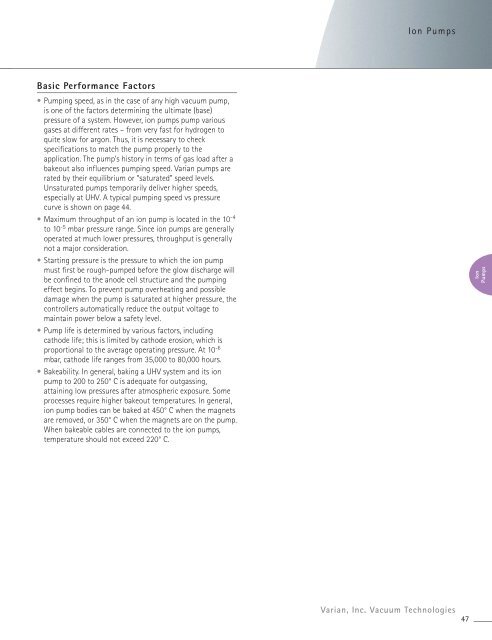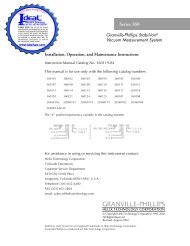Ion Pumps Varian, Inc. Vacuum Technologies - Ideal Vacuum Products
Ion Pumps Varian, Inc. Vacuum Technologies - Ideal Vacuum Products
Ion Pumps Varian, Inc. Vacuum Technologies - Ideal Vacuum Products
You also want an ePaper? Increase the reach of your titles
YUMPU automatically turns print PDFs into web optimized ePapers that Google loves.
<strong>Ion</strong> <strong>Pumps</strong><br />
Basic Performance Factors<br />
• Pumping speed, as in the case of any high vacuum pump,<br />
is one of the factors determining the ultimate (base)<br />
pressure of a system. However, ion pumps pump various<br />
gases at different rates – from very fast for hydrogen to<br />
quite slow for argon. Thus, it is necessary to check<br />
specifications to match the pump properly to the<br />
application. The pump’s history in terms of gas load after a<br />
bakeout also influences pumping speed. <strong>Varian</strong> pumps are<br />
rated by their equilibrium or “saturated” speed levels.<br />
Unsaturated pumps temporarily deliver higher speeds,<br />
especially at UHV. A typical pumping speed vs pressure<br />
curve is shown on page 44.<br />
• Maximum throughput of an ion pump is located in the 10 -4<br />
to 10 -5 mbar pressure range. Since ion pumps are generally<br />
operated at much lower pressures, throughput is generally<br />
not a major consideration.<br />
• Starting pressure is the pressure to which the ion pump<br />
must first be rough-pumped before the glow discharge will<br />
be confined to the anode cell structure and the pumping<br />
effect begins. To prevent pump overheating and possible<br />
damage when the pump is saturated at higher pressure, the<br />
controllers automatically reduce the output voltage to<br />
maintain power below a safety level.<br />
• Pump life is determined by various factors, including<br />
cathode life; this is limited by cathode erosion, which is<br />
proportional to the average operating pressure. At 10 -6<br />
mbar, cathode life ranges from 35,000 to 80,000 hours.<br />
• Bakeability. In general, baking a UHV system and its ion<br />
pump to 200 to 250° C is adequate for outgassing,<br />
attaining low pressures after atmospheric exposure. Some<br />
processes require higher bakeout temperatures. In general,<br />
ion pump bodies can be baked at 450° C when the magnets<br />
are removed, or 350° C when the magnets are on the pump.<br />
When bakeable cables are connected to the ion pumps,<br />
temperature should not exceed 220° C.<br />
<strong>Ion</strong><br />
<strong>Pumps</strong><br />
<strong>Varian</strong>, <strong>Inc</strong>. <strong>Vacuum</strong> <strong>Technologies</strong><br />
47

















